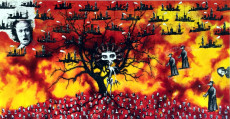
Panorama of German art in the 1920s

About the exhibition on New Objectivity at the Centre Pompidou in Paris from 11 May to 5 September 2022.
It is easy to imagine the cataclysmic atmosphere in Germany at the end of the First World War. And yet, the fragile Weimar Republic, which managed to establish itself despite violent tensions and coups d'état, was dubbed the "Republic of the Arts" in the 1920s. It quickly became a hotbed of new ideas. It was here that the architect Walter Gropius founded the Bauhaus in 1919, the institute of arts and crafts that shaped design and anchored modernity. But it was also here that countless artists kicked the anthill of Expressionism and its "feverish and overflowing subjectivism", as Manuel Jover describes it in the Connaissance des Arts article devoted to the exhibition to be held at the Musée national d'art moderne, Centre Pompidou in Paris from 11 May to 5 September: "Germany / 1920s / New Objectivity / August Sander".
In opposition to this subjectivism, Gustav Friedrich Hartlaub, the director of the Kunsthalle in Manheim, had the idea of calling the great exhibition he organised in 1925 "New Objectivity" to bring together all these new talents. Indeed, "it is difficult to understand how approaches as opposed as the timeless, disembodied, classicising realism of Alexander Kanoldt, Georg Schrimpf or Carlo Mense could be brought together under the same banner, and the acidic verism, to the point of caricature, in direct contact with social reality, of a Georg Grosz and an Otto Dix, or the clinical precision of a Christian Schad. Nevertheless, even if Hartlaub makes a distinction between a "right wing" typical of what has been called the "return to order", and a "left wing" inspired by Dadaism, concerned with denouncing the chaos of the contemporary world... a common point effectively unites them. It is depersonalisation.
Look closely at these empty expressions, these strange landscapes, this merciless lucidity. We are far from the exalted Expressionism. In these paintings everything is cold. The object reigns supreme. Humanity has given way to it. Mechanism from the United States has mechanised work, technology has mechanised people. And works of art have lost their soul. Manuel Jover does not hesitate to speak of a "silence of the heart". It's only a short step from there to thinking that this icy cynicism is a premonition of the 1929 crisis and of what will follow. An easy step, moreover, when one knows how sensitive artists are to the vibrations of the world. And this world, which in 1933 will see them called "degenerates", does not have a discreet vibration. The painters Georg Grosz, Otto Dix and Max Beckmann, as well as the photographers Albert Renger-Patzsch and August Sander, made no secret of the fact that they wanted to denounce militarism and war, that they did not want to conceal the shocking and violent aspects of the society of their time, and that they did not want to embellish the living conditions in the modern city.
Historians extend the concept of New Objectivity to all areas of creativity during the Weimar Republic. In literature, Bertold Brecht, Alfred Döblin or Herman Broch are to be mentioned. In music, Kurt Weill or Paul Hindemith. In cinema, some of Pabst's films. And in architecture, of course, there is the "New Construction". But in the end it was photography that was best able to document the reality of this period. The exhibition at the Centre Pompidou is the first comprehensive overview in France of the art and culture of the New Objectivity period, bringing together painting and photography, as well as architecture, design, film, theatre, literature and music. The brilliant idea of not losing our way in this multidisciplinary panorama is that it is structured around the various chapters of August Sander's great work, "Men of the 20th Century".




































































